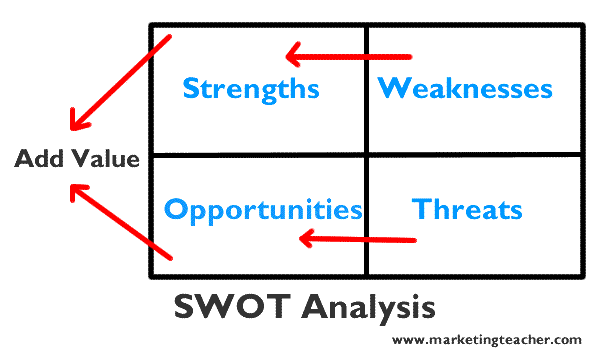SWOT Analysis
SWOT analysis is a tool for auditing an organization and its environment. It is the first stage of planning and helps marketers to focus on key issues. SWOT stands for strengths, weaknesses, opportunities, and threats. Strengths and weaknesses are internal factors. Opportunities and threats are external factors. A strength is a positive internal factor. A weakness is a negative internal factor. An opportunity is a positive external factor. A threat is a negative external factor.

We should aim to turn our weaknesses into strengths, and our threats into opportunities. Then finally, SWOT will give managers options to match internal strengths with external opportunities. The outcome should be an increase in ‘value’ for customers – which hopefully will improve our competitive advantage.
The main purpose of the analysis has to be to add value to our products and services so that we can recruit new customers, retain loyal customers, and extend products and services to customer segments over the long-term. If undertaken successfully, we can then increase our Return On Investment (ROI).
Simple rules.
- Be realistic about the strengths and weaknesses of your organization.
- It should distinguish between where your organization is today, and where it could be in the future.
- It should always be specific. Avoid grey areas.
- Always apply the tool in relation to your competition i.e. better than or worse than your competition.
- Keep your audit short and simple. Avoid complexity and over analysis
- It is subjective.
Once key issues have been identified with your SWOT analysis, they feed into marketing objectives. The tool can be used in conjunction with other tools for audit and analysis, such as PEST analysis and Porter’s Five-Forces analysis. So SWOT is a very popular tool with marketing students because it is quick and easy to learn. During the SWOT exercise, list factors in the relevant boxes. It’s that simple. Below are some FREE examples of SWOT analysis – click to go straight to them.
Strengths and weaknesses are internal factors.
For example:
A strength could be:
- Your specialist marketing expertise.
- A new, innovative product or service.
- Location of your business.
- Quality processes and procedures.
- Any other aspect of your business that adds value to your product or service.
A weakness could be:
- Lack of marketing expertise.
- Undifferentiated products or services (i.e. in relation to your competitors).
- Location of your business.
- Poor quality goods or services.
- Damaged reputation.
Opportunities and threats are external factors.
For example:
An opportunity could be:
- A developing market such as the Internet.
- Mergers, joint ventures or strategic alliances.
- Moving into new market segments that offer improved profits.
- A new international market.
- A market vacated by an ineffective competitor.
A threat could be:
- A new competitor in your home market.
- Price wars with competitors.
- A competitor has a new, innovative product or service.
- Competitors have superior access to channels of distribution.
- Taxation is introduced on your product or service.
A word of caution – it can be very subjective. Do not rely on SWOT too much. Two people rarely come-up with the same final version of SWOT. TOWS analysis is extremely similar.
Do you need a more advanced SWOT Analysis?
Some of the problems that you may encounter with SWOT are as a result of one of its key benefits i.e. its flexibility. Since SWOT analysis can be used in a variety of scenarios, it has to be flexible. However this can lead to a number of anomalies. Problems with basic SWOT analysis can be addressed using a more critical POWER SWOT.
History of SWOT Analysis
Having arrived on this page you have probably surfed the Internet and scoured books and journals in search of the history of SWOT Analysis. The simple answer to the question What is SWOT? is that there is no simple answer, and one needs to demonstrate a little academic wisdom in that nobody took the trouble to write the first definitive journal paper or book that announced the birth of SWOT Analysis. There are a number of contrasting, if not contradictory views on the origin of SWOT. Here are a few of the leading thinkers on the topic (and if you have more please let us know so that we can add them). More . . .
FREE SWOT Analysis Examples
A summary of FREE SWOT analyses case studies are outlined in our Lesson Store.
Comments